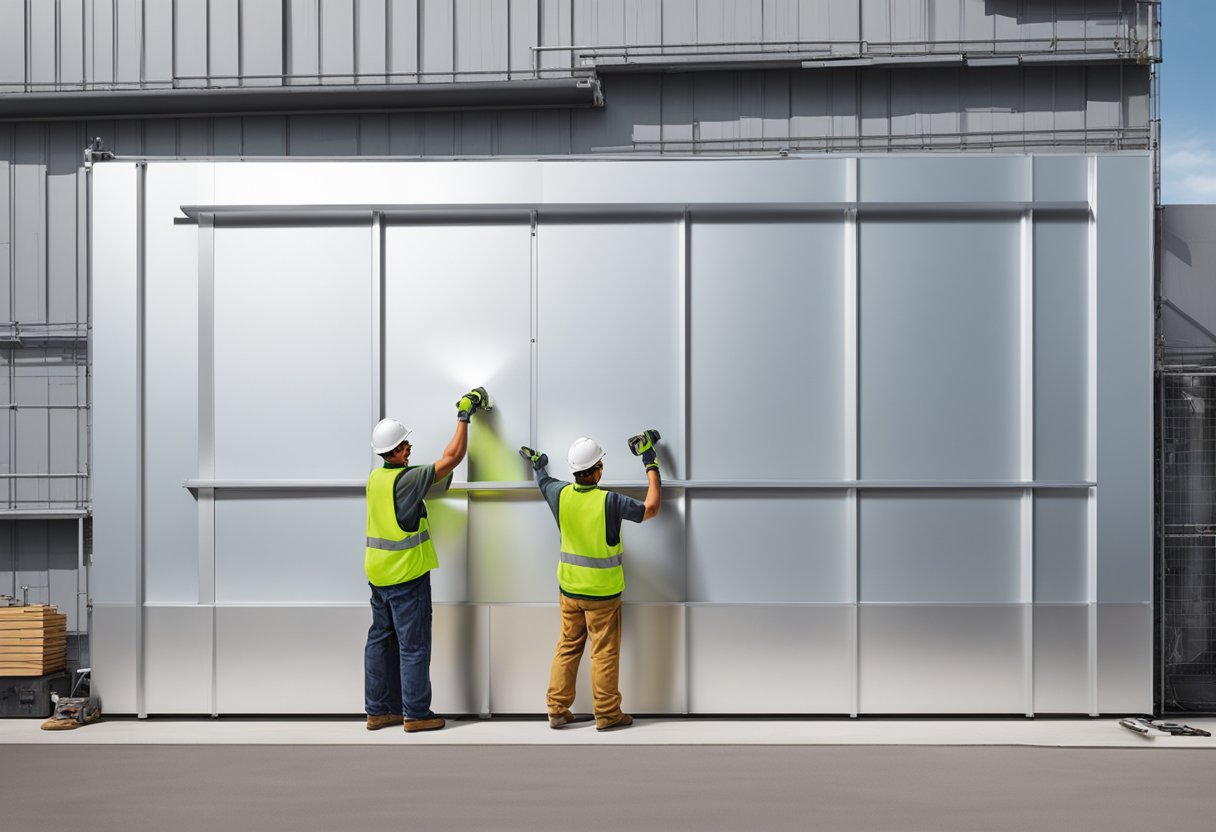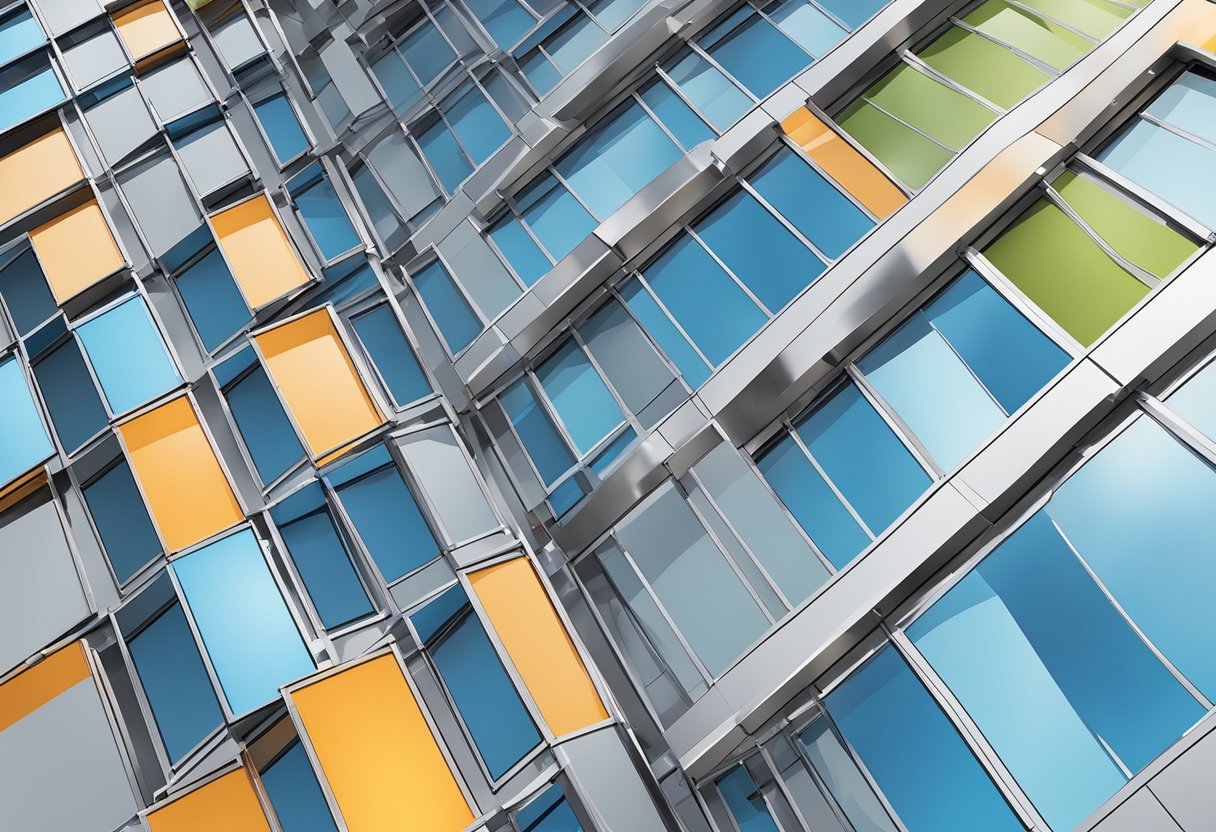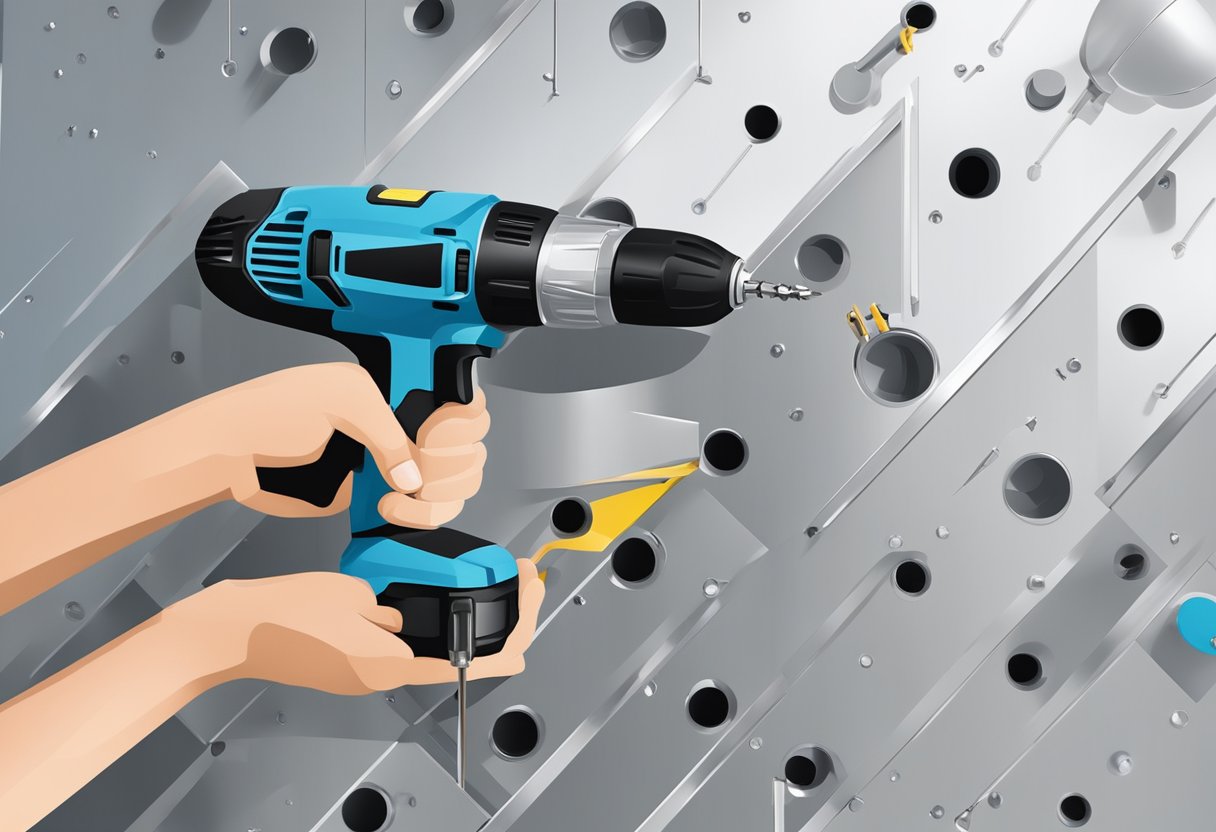Aluminum panel installation is a common practice in the construction industry. These panels are lightweight, durable, and easy to install, making them a popular choice for both commercial and residential buildings. They are commonly used for exterior cladding, roofing, and interior wall panels.

One of the main advantages of aluminum panels is their versatility. They come in a variety of colors, finishes, and textures, allowing for endless design possibilities. They can be cut to any size and shape, making them ideal for complex architectural designs. Additionally, aluminum panels are resistant to corrosion, weathering, and fire, making them a safe and long-lasting option for buildings.
Installing aluminum panels requires proper planning and expertise. The panels must be installed correctly to ensure their durability and longevity. This involves proper framing, anchoring, and sealing to prevent water penetration and air leakage. In this article, we will discuss the basics of aluminum panel installation, including the tools and materials needed, the installation process, and common mistakes to avoid.
Overview of Aluminum Panel Systems

Aluminum panel systems are a popular choice for exterior cladding due to their durability, versatility, and aesthetic appeal. These systems consist of lightweight panels made from aluminum or aluminum composite material (ACM) that are attached to a building’s exterior using a variety of fastening methods.
One of the key benefits of aluminum panel systems is their ability to provide a sleek, modern look to buildings. They can be customized to a wide range of colors, finishes, and textures, allowing architects and designers to achieve their desired aesthetic. Additionally, aluminum panel systems are available in a variety of sizes and shapes, making them suitable for a wide range of applications.
Another advantage of aluminum panel systems is their durability. These panels are resistant to corrosion, weathering, and impact, which makes them ideal for use in harsh environments. They are also fire-resistant, which can help to improve the safety of buildings.
Aluminum panel systems are typically installed using a variety of fastening methods, including concealed fasteners, exposed fasteners, and adhesive bonding. The choice of fastening method will depend on a variety of factors, including the size and shape of the panels, the location of the building, and the desired aesthetic.
Overall, aluminum panel systems offer a versatile, durable, and aesthetically pleasing option for exterior cladding. With a wide range of customization options and fastening methods, these systems can be tailored to meet the specific needs of any building project.
Tools and Materials Required

Safety Equipment
Before starting the aluminum panel installation, it is important to ensure that the necessary safety equipment is available. The following safety equipment should be used during the installation process:
- Safety glasses or goggles to protect the eyes from debris and dust
- Work gloves to protect the hands from sharp edges and cuts
- Hard hat to protect the head from falling objects
Installation Tools
The following installation tools are required for installing aluminum panels:
- Power drill with drill bits
- Measuring tape
- Chalk line
- Circular saw or jigsaw
- Screwdriver
- Level
- Caulking gun
- Hammer
- Nibbler
Materials Checklist
The following materials are required for installing aluminum panels:
- Aluminum panels
- Screws
- Sealant
- Backer rod
- Foam tape
- Z clips or J channels
- Corner trim
It is important to ensure that all the necessary tools and materials are available before starting the installation process. This will help to ensure that the installation process is completed smoothly and efficiently.
Pre-Installation Planning
Before installing aluminum panels, it is important to carefully plan and prepare the site. This includes assessing the site, designing and laying out the panels, and obtaining necessary permits and complying with building codes.
Site Assessment
A thorough site assessment is crucial to ensure that the installation of aluminum panels is successful. The assessment should consider factors such as the condition of the building, the location of utilities, and any potential hazards. It is also important to assess the weather conditions and the potential impact on the installation process.
Panel Design and Layout
The design and layout of the aluminum panels should be carefully planned before installation. This includes determining the size and shape of the panels, as well as the color and finish. It is important to consider the aesthetic appeal of the panels, as well as their functionality and durability.
Building Codes and Permits
Before installing aluminum panels, it is important to obtain any necessary permits and comply with building codes. This may include obtaining a permit from the local government, complying with fire safety regulations, and ensuring that the installation meets all applicable codes and standards.
Overall, careful planning and preparation are essential for a successful aluminum panel installation. By assessing the site, designing and laying out the panels, and complying with building codes and permits, the installation process can be completed safely and efficiently.
Installation Techniques
Panel Cutting and Shaping
Aluminum panels can be easily cut and shaped to fit any design or layout. A variety of tools can be used for cutting, including circular saws, jigsaws, and table saws. It is important to use the correct blade or bit for the material being cut to ensure a clean and accurate cut.
Shaping the panels can be done using a variety of techniques, including bending, folding, and curving. This can be achieved using specialized tools or by using a brake press. It is important to ensure that the panels are shaped correctly to prevent any damage or distortion.
Fastening Methods
There are several fastening methods that can be used to install aluminum panels. The most common method is through the use of screws or rivets. It is important to use the correct fasteners for the material being installed and to ensure that they are installed at the correct spacing and depth.
Another popular method is through the use of adhesives. This method is often preferred for its clean and seamless appearance. It is important to use a high-quality adhesive that is designed for use with aluminum panels and to follow the manufacturer’s instructions for application.
Sealing and Waterproofing
Sealing and waterproofing the installation is an important step in ensuring the longevity of the aluminum panels. This can be achieved through the use of sealants and gaskets. It is important to use a sealant that is compatible with the material being installed and to ensure that all joints and seams are properly sealed.
In addition, it is important to ensure that the installation is properly flashed to prevent any water infiltration. This can be achieved through the use of flashing tape or other waterproofing materials. It is important to follow the manufacturer’s instructions for installation to ensure a proper seal.
Mounting Aluminum Panels
Substructure Installation
Before mounting aluminum panels, it is crucial to have a proper substructure installed. The substructure should be made of durable materials such as steel or aluminum to ensure stability and longevity. It is recommended to use a substructure with a minimum thickness of 14 gauge. The substructure should also be installed with proper spacing and alignment to ensure the panels can be mounted correctly.
Panel Alignment and Placement
Once the substructure is installed, it’s time to align and place the aluminum panels. It is important to ensure that the panels are aligned correctly and spaced evenly to create a clean and professional look. The panels should be placed in a way that allows for expansion and contraction due to temperature changes. It is recommended to use a gap of at least 1/8 inch between panels.
To ensure proper alignment, use a laser level or a string line to create a straight line for the panels to follow. It is also recommended to use a panel adhesive to secure the panels to the substructure. This will help prevent any movement or rattling of the panels over time.
Overall, proper substructure installation and panel alignment are crucial for a successful aluminum panel installation. Following these steps will ensure a professional and long-lasting installation.
Finishing Touches
Trim and Flashing
Once the aluminum panels have been installed, it’s time to add trim and flashing to complete the look and ensure a watertight seal. Trim and flashing are essential for protecting the edges of the panels and preventing water from seeping in.
There are several types of trim and flashing available, including J-trim, L-trim, and Z-flashing. The type of trim and flashing used will depend on the specific installation and the desired aesthetic.
It’s important to ensure that the trim and flashing are properly installed and sealed to prevent any leaks. This can be done using screws or adhesive, depending on the type of trim and flashing used.
Caulking and Sealants
Caulking and sealants are another important component of aluminum panel installation. They are used to seal any gaps or joints between panels and trim, as well as around windows and doors.
There are a variety of caulking and sealant options available, including silicone, polyurethane, and acrylic. It’s important to choose a sealant that is compatible with the aluminum panels and trim being used.
When applying caulking and sealants, it’s important to follow the manufacturer’s instructions and use the appropriate tools and techniques. This will ensure a proper seal and prevent any water from seeping in.
Overall, the finishing touches of aluminum panel installation are crucial for a successful and long-lasting installation. Properly installed trim and flashing, as well as appropriate caulking and sealants, will ensure a watertight seal and a professional-looking finish.
Inspection and Quality Control
Before installing aluminum panels, it is important to thoroughly inspect them for any defects or damage. This includes checking for scratches, dents, or any other imperfections that may affect the performance of the panels. Any damaged panels should be replaced before installation to ensure the best possible outcome.
In addition to visual inspection, quality control measures should also be in place to ensure that the panels meet the required standards. This includes testing for strength, durability, and weather resistance. These tests can be conducted in-house or by a third-party testing facility.
During installation, it is important to maintain quality control measures to ensure that the panels are installed correctly and meet the required standards. This includes ensuring that the panels are properly aligned, secured, and sealed to prevent any air or water leaks. Any issues should be addressed immediately to prevent further damage or potential safety hazards.
Overall, proper inspection and quality control measures are essential for ensuring that aluminum panels are installed correctly and perform as expected. By following these guidelines, contractors can ensure that their installations meet the required standards and provide long-lasting performance.
Maintenance and Cleaning
Regular maintenance and cleaning of aluminum panels is essential to ensure the longevity and aesthetic appeal of the installation. Here are some tips to keep in mind:
- Inspect regularly: It is important to inspect the aluminum panels regularly to identify any signs of damage or wear. Any dents, scratches, or other damages should be addressed promptly to prevent further damage.
- Clean with mild detergents: To clean the aluminum panels, use mild detergents and a soft cloth or sponge. Avoid using abrasive cleaners or steel wool, as they can scratch or damage the surface of the panels.
- Rinse thoroughly: After cleaning, rinse the panels thoroughly with clean water to remove any soap residue. Failure to rinse thoroughly can leave streaks or spots on the surface of the panels.
- Avoid harsh chemicals: Avoid using harsh chemicals such as bleach or ammonia on the aluminum panels, as they can cause discoloration, corrosion, or other damage.
- Check for corrosion: Corrosion can occur on aluminum panels, particularly in areas with high humidity or salt exposure. Regular inspections can help identify any signs of corrosion, such as white or gray powdery deposits on the surface of the panels.
By following these maintenance and cleaning tips, you can help ensure that your aluminum panel installation remains in top condition for years to come.
Troubleshooting Common Issues
During the installation of aluminum panels, there are a few common issues that may arise. These issues can be easily resolved with some troubleshooting techniques. Here are some common issues and their solutions:
Buckling or Warping
Buckling or warping of aluminum panels can occur due to improper installation or inadequate support. To prevent this issue, ensure that the panels are installed with proper support and that the fasteners are tightened to the recommended torque. If buckling or warping has already occurred, it may be necessary to remove the panels and reinstall them with additional support.
Oil Canning
Oil canning is a common issue that occurs when the flat panels appear wavy or distorted. This issue can be caused by a variety of factors, including improper installation, uneven substrate, or thermal expansion. To prevent oil canning, ensure that the substrate is even and that the panels are installed with proper support. If oil canning has already occurred, it may be necessary to replace the panels.
Corrosion
Corrosion can occur when aluminum panels are exposed to corrosive substances or environments. To prevent corrosion, ensure that the panels are properly coated or painted to protect them from exposure. If corrosion has already occurred, it may be necessary to replace the affected panels.
Scratches or Dents
Scratches or dents can occur during the installation process or during normal use. To prevent scratches or dents, handle the panels with care during installation and use. If scratches or dents have already occurred, they can be repaired with touch-up paint or by replacing the affected panels.
By following these troubleshooting techniques, common issues that arise during the installation of aluminum panels can be easily resolved, ensuring a successful installation.



